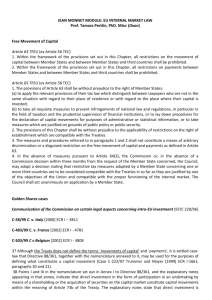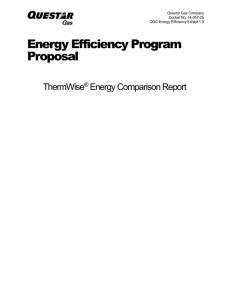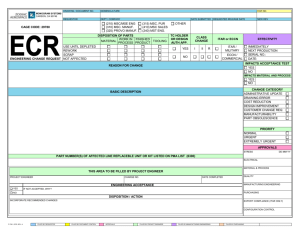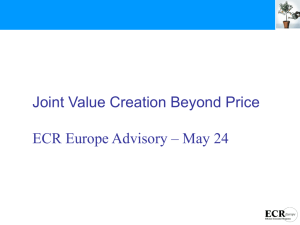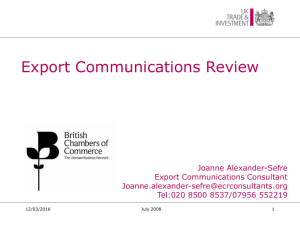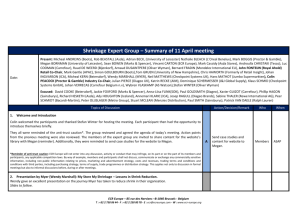Electronic Commerce Council of Canada
advertisement
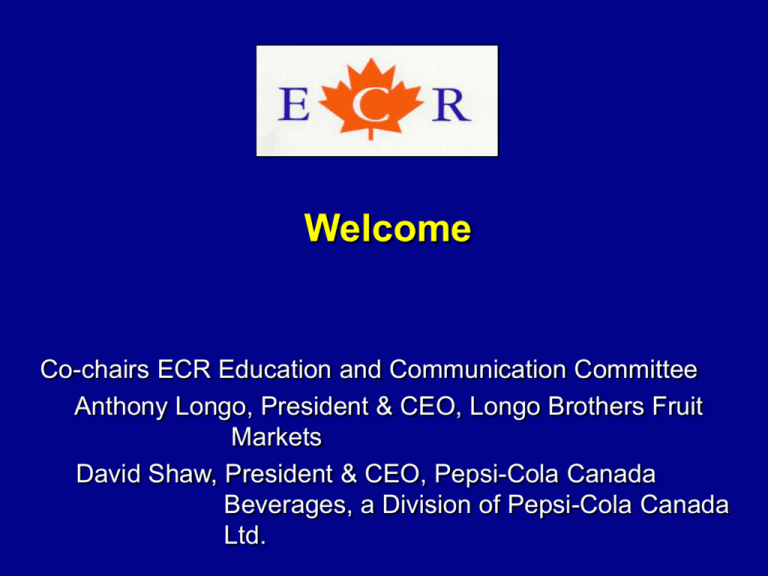
Welcome Co-chairs ECR Education and Communication Committee Anthony Longo, President & CEO, Longo Brothers Fruit Markets David Shaw, President & CEO, Pepsi-Cola Canada Beverages, a Division of Pepsi-Cola Canada Ltd. Canadian ECR Initiative The Nuts and Bolts of Implementation September 24, 1998 Presented by: ECR Steering Committee Co-chairs Lawrence Strong, President & CEO, Unilever Canada Limited Allister Graham, Chairman & CEO, The Oshawa Group Limited ECR Sponsors ECR INDUSTRY MODEL INVOLVEMENT / COMMITMENT LOW Proprietary MEDIUM HIGH Non Proprietary ECR INDUSTRY MODEL INVOLVEMENT / COMMITMENT LOW MEDIUM Proprietary •Category Management •CRP HIGH Non Proprietary •Barcode Standards •EDI Standards •Unsaleables Solution ECR INDUSTRY MODEL INVOLVEMENT / COMMITMENT LOW Proprietary •COMMITMENT to Information Sharing on best practices MEDIUM HIGH Non Proprietary •COMMITMENT to Implementation •Common industry priorities •Agreed to industry action plan ECR Enablers HIGH Commitment Implementation Initiatives • Scan Data Integrity • Case Barcoding Critical Mass Target ECR Enablers HIGH Commitment Implementation Initiatives • Scan Data Integrity • Case Barcoding Critical Mass Target • Establishment of Electronic Commerce Council ECR Enablers HIGH Commitment Implementation Initiatives • • • • Scan Data Integrity Case Barcoding Critical Mass Target Establishment of Electronic Commerce Council EDI Standards Compliance & Critical Mass Targets ECR Enablers HIGH Commitment Implementation Initiatives • • • • Scan Data Integrity Case Barcoding Critical Mass Target Establishment of Electronic Commerce Council EDI Standards Compliance & Critical Mass Targets • Industry Unsaleables Solution Implementation ECR Enablers HIGH Commitment Implementation Initiatives • • • • Scan Data Integrity Case Barcoding Critical Mass Target Establishment of Electronic Commerce Council EDI Standards Compliance & Critical Mass Targets • Industry Unsaleables Solution Implementation • Scorecard Benchmarking System ECR Enablers HIGH Commitment Implementation Initiatives • • • • Scan Data Integrity Case Barcoding Critical Mass Target Establishment of Electronic Commerce Council EDI Standards Compliance & Critical Mass Targets • Industry Unsaleables Solution Implementation • Scorecard Benchmarking System • Canadian Space Databank Foundation Transfer to Create Industry Online Product Catalogue ECR Enablers ECR Leadership has Started Other Industry Initiatives • Efficient Foodservice Response (EFR) • Drug Industry (ECRx) • HealthCare (EHCR) Electronic Commerce Council Hosts WEBSITES for ECR, EFR, ECRx, EHCR ECR YEAR 2000 VISION Key Messages for the Future • • • • • • ECR continues to evolve ECR institutionalized in companies ECR now a global initiative ECR benefits need re-enforcement ECR will drive Activity-Based Costing Consumer Wins! ECR Sponsors Scorecard Committee Report September 24, 1998 Presented by: ECR Industry Scorecard Committee Co-Chairs Irene Rosenfeld, President, Kraft Canada Inc. Doug Stewart, Vice Chairman & CEO, Sobey’s Inc. Scorecard Design Objectives • Keep it Simple • Focus on Canadian Enabler Initiatives • Use Website Data Collection and Password Protection for Data Security Two Types of Information Level of ECR Implementation Scoring Critical Mass Implementation Statistics Scorecard Focus To Evaluate Total Efficient Replenishment With Five Views : 1. EDI IMPLEMENTATION 2. BARCODING IMPLEMENTATION 3. REPLENISHMENT PROCESS IMPLEMENTATION 4. CONTINUOUS REPLENISHMENT (CRP) 5. CUSTOMER SERVICE IMPLEMENTATION Canadian Scorecard Objectives Objective 1 Trading Partner Dialogue •Specific Action Plans with Timetables for Implementation Between Trading Partners Canadian Scorecard Objectives Objective 2 Industry Benchmarking •Provide Gap Analysis (Self Assessment) versus Industry Average and Best Practice Canadian Scorecard Objectives Objective 3 Critical Mass Feedback •Generate Industry Initiatives to Continue Progress in Overcoming Barriers Scorecard Utilization Recommendations • Individual Company Self -Assessment • Annual Reviews to track Progress • Generate Action Plans with Internal Multi-Functional Teams – – – – – Distribution / Logistics / Customer Service Merchandising / Marketing Systems / Finance Manufacturing Senior Management Scorecard Utilization Recommendations • Trading Partner Cross - Assessment • Initiate Trading Partner Dialogue by Exchanging Self-Assessment Scorecards • Annual Business Review meetings of MultiFunctional Teams to develop mutual ECR Implementation Action Plans The ECR Steering Committee Invites You to Score Yourself Check it out www.ecr.ca ECR Unsaleables Committee Progress Report September 24, 1998 Presented by: ECR Unsaleables Committee Co-Chairs Al Graham, Chairman & CEO, The Oshawa Group Limited Brian Mirsky, President, Campbell Soup Company Ltd Let’s Review … A Case for Change Trading Partners • Were not satisfied with previous joint industry recommendations • No incentive to reduce the incidence of unsaleables. Distributors • Did not feel they were adequately compensated. • The handling rate did not cover their costs. Manufacturers • Saw unsaleables as ever increasing cost with no accountability. ECR Vision - to eliminate / minimize unsaleables in the supply chain ECR Unsaleables Recommendation Objective; “To facilitate a cost effective reduction in the incidence of unsaleables products through fair and equitable practices.” ECR Unsaleables Solution - Principles • • • • • Be compatible with the philosophy & principles of ECR Address & resolve issues in a least cost manner, with an Accountability & a monitoring-audit capability. Unacceptable practices should bear the cost Not for profit solution. ECR Unsaleables Solution - Components • Recommendation includes handling rates which more accurately reflects distributors costs. • Distributor compensation for unsaleables is determined by performance versus a declining industry benchmark. What’s new in 1998… ….. Progress report CCGD Board endorsed the recommendation. November 24, 1997 FCPMC members voted yes January 1, 1998 - Ontario Roll-out began March 1, 1998 - User’s Guide published July 21, 1998 - Joint industry recommendation for a National Roll-out to commence November 1, 1998. So How Are We Doing So Far? Top Line Observations of the Ontario Roll-out • Prior to the roll-out, the average rate of incidence for the industry was measured at 15 items / $10,000 retail sales. • Three distributors are currently participating in the Ontario roll-out. • All 3 are performing below the current industry benchmark of 13 items / $10,000 retail sales. • Representing collective performance 13% below the previous year’s industry average. There is a Lot of Work Still to be done…. Next Steps • National Roll-out to begin November 1, 1998. • Regional Seminars will be conducted during October / November • Evaluation of 1998 Ontario roll out – evaluation of handling rates and, – declining benchmarks going forward • Work groups to address product categories outside the current recommendation. Next Steps continued… Further development of the trading partners roles • We now have actionable data & the incentive to act on it. • Trading partners will have to initiate dialogues to address identified issues. What can you do next? • If you haven’t already, buy a User’s Guide. • Attend the breakout session. • Who should attend? Barcoding and EDI Implementation September 24, 1998 Presented by: Dave Morton, President & CEO, The Quaker Oats Company of Canada Limited Nick Jennery, President & CEO, CCGD. Canadian Barcode Initiative Selling Unit Case Pallet Canadian Selling Unit Barcode Initiative • Progress strong with accuracy 99%+ Validation procedures in place • Driving efficiency in Canadian Industry Canadian Case Barcode Initiative Current Situation • Required to drive efficiencies – Warehouse receiving – Warehouse picking accuracy – D.S.D. receiving • Canadian Standard case bar code one side • Some distributors live - others investing Canadian Case Barcode Initiative Current Issues • May survey - 60% cases with bar codes • Efficiency require critical mass • Some suppliers hesitate to invest • Quality/Accuracy an ongoing challenge Canadian Case Barcode Initiative Next Steps • Grace period established to January, 1999 • “All Distributors will take the action required to ensure compliance to the January 1999 deadlines” • Cost recovery a real possibility Canadian Pallet License Plate/ASN Initiative Part of Canadian Supply Chain Vision • Supports efficient distribution/receiving/warehousing • Each pallet “Bar Coded” with license plate • Supported by Advanced Ship Notice Transaction Canadian Industry EDI Overview • EDI A Key Enabler To Overall Supply Chain Cost Reduction — Provides accurate and timely information — Reduces manual effort — Eliminates many errors — Supports many ECR initiatives Canadian Industry EDI Overview Current Status • Canadian Industry Progress - Unsatisfactory – Limited to P.O. and Invoices – Advanced practitioners few - little benefit • Key Industry Issue - Critical Mass – Broad EDI transaction base – Wide partner usage Canadian Industry EDI Overview Barrier to Development • • • • • Benefits unique/tough to quantify Large - long-term investment Competing corporate priorities - Year 2000 Multiple versions - Labour intensive Overall - Lack of future vision Canadian Industry EDI Overview Key Initiatives 1) Industry Adoption VIC’s 4010 – – – – Year 2000 capable General merchandising standard Canadian Industry Implementation Guide Broad Industry endorsement May 1999 Conversion Deadline Canada Safeway Ltd. Co-op Atlantic Federated Co-operators Ltd. Great A&P Co. Canada Ltd. Loblaw Companies Ltd. Metro-Richelieu Inc. Overwaitea Food Group Provigo Inc. Sobeys Inc. The Oshawa Group Ltd. Thrifty Foods Unilever Cda. Ltd. The Quaker Oats Co. of Cda. Ltd. Proctor & Gamble Inc. Pepsi-Cola Canada Ltd Parmalat Canada Ltd. Kraft Canada Inc. FBI Brands Ltd. Coca-Cola Ltd. Indicate in the appropriate box the planned date for moving to the EDI-4010 standard for each trading partner Culinar Inc. ECR Canadian Grocery Industry Migration Schedule to EDI VICS-4010 Standard Latest Scheduled Date Is To Be May 1999 Canadian Industry EDI Overview Key Initiatives 2) Industry Adoption - Supply Chain Vision – Covers 4 major Supply Chain processes • • • • Data Alignment Efficient Replenishment Physical Distribution/Warehousing Financial Reconciliation – Specific EDI transactions/timing Canadian Industry EDI Overview Summary • Major financial benefits • Execution of implementation plan critical Unexplained Deductions September 24, 1998 Presented by: Bill McEwan, President & CMO, The Great Atlantic & Pacific Company of Canada, Limited Taking the “Unexplained” Out Of Deductions Deductions Are Not Necessarily A Problem This Is A Business Process Issue Result - Costly Non-Productive Activities Deduction Descriptions Unexplained - Inadequate Or No Documentation Unresolved - Valid Deductions, Agreed By Both Trading Partners, But Not Adequately Documented or Communicated Unauthorized - Not Agreed To By Supplier And Distributor - “Random Act Of Violence” Results Of 1996 Survey Canadian Grocery Distributors Process 1.4 Million Deductions Annually Represents $1.8 Billion Dollars 90 Percent Of Deductions Are Valid Cost The Industry $30 Million To Resolve Them - $27 Million - Suppliers’ Costs - $ 3 Million - Distributors’ Costs Efficient Deductions Process Unexplained Deductions Trading Relationship A D 90% Deductions As… Legitimate Business Process C B A Trading Relationship B Trading Relationship C Trading Relationship D Deduction Responsibility …not just Distributor Accounting …must include Merchandising Procurement Warehousing Operations more Supplier 78 Accounting 78 78 78 78 Marketing Sales Logistics Field Sales …and The Problem Can Be Solved Implementing The Committee’s Recommendations, including… Detailed Best Practices For Processing Deductions & Reducing Unexplained Deductions Revised Standard Forms Recommendations For The Implementation Of EDI Transaction Sets With Respect To Deductions Revised Deductions Guidelines Three Critical Imperatives Communicate Communicate Communicate Recommended Next Steps Attend The ECR Deductions Committee Break Out Session At 2:30 P.M. This Afternoon Buy The New ECR Publication “Taking The Unexplained Out Of Deductions” ECRx in the Drug Channel September 24, 1998 Presented by: Aldo Baumgartner, President & CEO, Wyeth-Ayerst Canada Leonard Marks, Vice-President, Cosmetics & Pharmacy, London Drugs STAKEHOLDER COMMITTEE Co-Chairs Leonard Marks Aldo Baumgartner London Drugs Ltd. Wyeth-Ayerst Canada Committee Larry Andrews Chris Bisanz David Bloom Claudio Bussandri Don Cameron François Coutu Brenda Drinkwalter Judy Erola Jeremy Ferdinands Frank Ferlaino Leroy Fevang Theresa Firestone Ronald Frisch AltiMed Pharmaceuticals FCPMC Shoppers Drug Mart Ltd. Medis Lawtons Drug Stores Le Groupe Jean Coutu CDMA PMAC Overwaitea Food Group Cosmair CPhA CWDA Kohl & Frisch STAKEHOLDER COMMITTEE …cont’d Co-Chairs Leonard Marks Aldo Baumgartner London Drugs Ltd. Wyeth-Ayerst Canada Committee Colleen Jay Steve Johnson Jack Kay Charles Low John Makepeace Gerry McDole Malcolm Seath Monika Simon Art Smith Gersh Sone Robert White Procter & Gamble Mead Johnson Apotex CCTFA Wal-Mart Canada Inc. Astra Pharma Inc. Whitehall Robins CACDS ECCC Pharmx Rexall NDMAC ECRx CATEGORIES • Rx • OTCs • Cosmetics ECRx ENABLERS • Barcoding • Electronic Data Interchange (EDI) • Central Product Catalogue • Scorecarding INDUSTRY ASSOCIATIONS “UNITED WE STAND….. DIVIDED WE FALL” Efficient Foodservice Response September 24, 1998 Presented by: Co-Chairs, Canadian EFR Steering Committee Peter McLaughlin, President, Clover Group Gord Wilson,General Manager, Nabisco Out of Home Channels Division EFR Completes the Food Supply Chain Puzzle 1972 Efficient Foodservice Response C O N S U 1972 Efficient Consumer Response M E Quick Response R S Canadian EFR Vision • To facilitate a more competitive, demand-driven foodservice supply chain, by encouraging adoption of recommended Best Practices for industry-wide processes EFR Motivators (Why do we need it?) Eroding Profit Margins Time Poor, Value Conscious Consumer Adversarial Relationships Foodservice Supply Chain Channel Blurring Operator Labor New Technology Enablers Lack of Basic Capabilities NonTraditional Competition Synergy with ECR, timing is right! Why should we do EFR? • 1996 KPMG supply chain review concluded: – 52 days of inventory in the supply chain – Supply chain technology not well used – Potential savings: $400 million (Canada) • 1997 U.S. study -- $14 billion annual savings Savings share by segment (U.S.) (Source: 1997 FDI EFR Report) 28 % 1% 36 % 35 % Manufacturer Distributor Operator Broker Process in Canada •- Steering Committee comprised of manufacturers, distributors, operators, brokers •- 4 “project” committees each co-chaired by manufacturer & distributor •- EFR Steering Committee aligned with ECR Steering Committee; - share learnings, avoid duplication, share resources •- 4 sponsoring associations (secretariats & resource support) •- Co-operative alliance with U.S. EFR initiative FCPMC CCGD EFR ECR CFBA Product ID Bar Code ECCC U.S. EFR Electronic Commerce Supply Chain Demand Forecasting Education/Communication Principles …. •Agenda based on common enablers pertinent to all companies, irrespective of size or sector. •Companies to “pilot” recommendations to identify implementation issues and critical success factors. •Participating companies to set an example by implementing EFR recommendations. What are we doing? 4 EFR Committees 1. Product Identification/Barcodes 2. Electronic Commerce 3. Supply Chain Demand Forecasting 4. Communications and Education What are we doing? •Three project committees to: –assess situation in foodservice industry through surveys, etc. (form hypotheses, assumptions) –conduct pilots and/or studies to determine “business case”, critical success factors, barriers to implementation –publish “best practice” recommendations in report to industry –scorecard and benchmark Product Identification/ Barcodes Objective: •To implement and use standard product identification codes as per industry (ECCC) standards and guidelines, including barcodes on SKUs, cases and pallets. Guiding Principle: •Use accurate and timely information in a computer-based system to support effective marketing, production and logistics decisions. Product Identification/ Barcodes Action: 1. Reviewed standards and ECR best practices 2. Mapped out business requirements to identify gaps for foodservice 3. Surveyed industry (April) to understand level of barcode activity and implementation readiness 4. Established recommended industry implementation timeline 5. Publishing “Barcoding Basics” report Product Identification/ Barcodes Recommendation: – UPC and SCC-14 numbers assigned to all products and cases, price lists updated, by October 31, 1998 – All cases marked with scannable barcodes by October 31, 1999 – Major distributors to sign-off and send letter to suppliers requesting compliance •Endorsed by EFR Steering Committee, FCPMC Foodservice members, CFBA Electronic Commerce Objective: •To integrate Electronic Commerce (EDI) into common business practices, from the order through to reconciliation. Electronic Commerce Action: 1. Survey of foodservice manufacturers, operators and distributors conducted. Information session for distributors held (April); 2. Pilots/projects underway: - Lipton/SERCA; Lynch/Gordon; Cara/Summit/Nabisco Business case (based on ABC analysis) being developed for each; 3. Technical analysis of applicability of VICS 4010 to foodservice being done Supply Chain Demand Forecasting Objective: •To develop communication and information sharing guidelines (bar coding, EDI, demand data sharing, etc.) that facilitate trading partner planning processes and results in the reduction of waste/cost throughout the supply chain. Supply Chain Demand Forecasting Action: 1. Extensive list of issues affecting the ability to effectively forecast developed: 2. Three separate Manufacturer/Distributor pilots established to test hypotheses regarding key issues of SCDF effect on inventory levels and communication; 3. Study conducted to identify operators’ perspectives regarding EFR, technology, and SCDF-related issues Education & Communications Objectives: •To communicate progress and promote participation in EFR initiatives to all participants in the foodservice supply chain through trade media and associations. Education & Communications Action: 1. Extensive mailing list 5,000+ of key audiences developed (operators, distributors, manufacturers, media, associations,etc.) 2. Associations actively spreading news (newsletters, events, press releases): CRFA to support communicating 3. Updates given at industry conferences/events: - September 24 session at ECR Conference - February 15 EFR Conference 4. Series of fax bulletins initiated 5. Presence on Web (through ECR) Summary •Work in progress--12 - 18 month timeframe to complete recommendations •Regular progress reports through associations, foodservice events •Quarterly Steering Committee meetings •Seek more operator involvement on all four committees Conclusion “The future just ain’t what it used to be” Yogi Berra Canadian ECR Initiative Centralized Product Catalogue September 24, 1998 Presented by: Jean Noelting, President, Cheese & Tablespread Division, Parmalat Canada Ltd. ANNOUNCING ECCnet The Online Industry Catalogue Canada Current CSDF Database Offering • Over 46,000 Items, Including Images, FMI measured Dimensions • Sponsored by FCPMC and CCGD • Information in English & French • UPC Certification Service Rationale for a Centralized Product Data Repository Economic Benefits for Single Industry Standard Manufacturers Distributors / Retailers To reduce costs of supporting multiple Distributors in multiple Channels To reduce costs of Building and Maintaining a Comprehensive Database Solution to Product Data Accuracy Rationale for a Centralized Product Data Repository Economies of Scale Opportunity to reduce costs and improve services by adding product volume from other channels •Drugs and Pharmacy,General Merchandise •Convenience, Hardware, Alcohol, Food Service •Electrical, Health Care, Computer Components Rationale for a Centralized Product Data Repository Single Industry Solution Overcomes Technology Investment Hurdle •Web Access •Broad Functionality Future Vision ECCnet WEB Central Database - Product - Location Suppliers Retailers/ Distributors Functionality Sales Management Planogram Location Data Base Marketing Item Synchronization - POS File - Logistics - Orders Gov’t Regulations/ Ingredients ECCnet Next Steps • ECR Grocery and ECRx Committee Established to finalize Industry requirements • Supplier / Marketer Accountabilities • Category Completion Activity for CSDF • Request for Proposal for Web Portion Issued • Targeted Implementation for Early 1999 ECCnet The Online Industry Catalogue Canada “IN HOC SIGNO VINCES” “ He who bears this sign will win” Emporera Constantine I 332 AD
